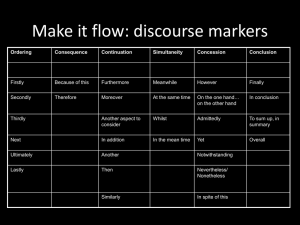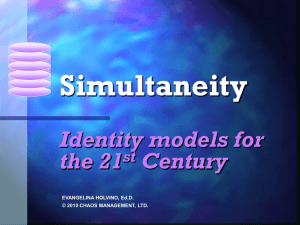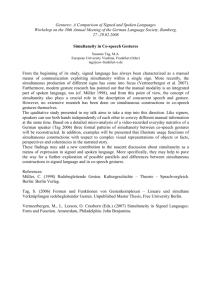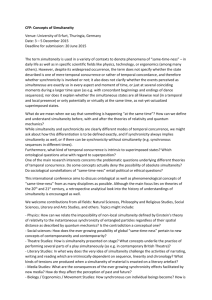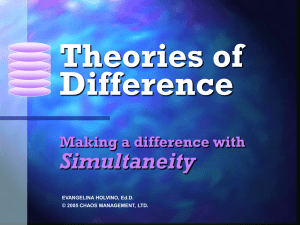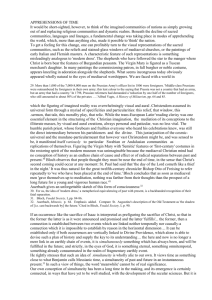The Time Traveler
advertisement
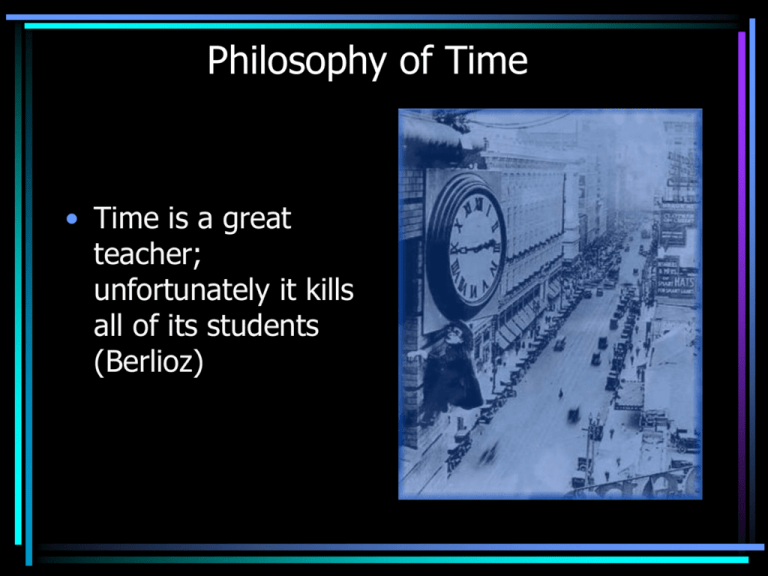
Philosophy of Time
• Time is a great
teacher;
unfortunately it kills
all of its students
(Berlioz)
I. The Problem
The manifest image is teaming with
activity. Objects are booming and buzzing
by, changing their locations and properties,
vivid perceptions are replaced, and we
seem to be inexorably slipping into the
future. Time—or at least our experience in
time—seems a very busy and complicated
sort of thing.
By contrast, time in the scientist image is
very peaceful. The ‘t’ in the fundamental
equations of physics doesn’t differentiate
between past and future, nor does it speed
up or slow down, nor does it pick out
which time is now.
We seem to have, to echo another debate,
an “explanatory gap” between time as we
find it in experience and time as we find it
in science.
Problem…
Time in physics is (at best) a non-unique 1-dimensional parameter
that partially orders 3-dimensional spatial slices.
Time in Physics
No present
No asymmetry
No flow
Is physics incomplete or inaccurate? Has it missed the properties of time
that cause these experiences? Or is the time of physics all the objective
time needed, where the rest can be explained with psychology,
environmental facts, and complicated interactions among them? I.e., is the
tensed or tenseless view of time is correct?
Tenseless Time
•
The past, present and future ‘equally’ exist.
•
The categories past, present and future are
not the fundamental temporal properties
for the detenser. The fundamental
temporal properties are the famous “Brelations” of McTaggart: before, after, and
being simultaneous with. ‘Past’ and ‘future’
are understood like ‘right’ and ‘left’, i.e.,
relationally.
•
The present according to the tenseless
view is not at all metaphysically special,
since the present for some event is merely
those events simultaneous with it (or
something more complicated along these
lines).
•
Russell, D.C. Williams, Grunbaum, …
H.G. Wells, The Time Traveler
http://www.marxists.org/reference/archive/hgwells/works/1890s
/time/ch01.htm
http://www.math.union.edu/~dpvc/math/4D/basics/welcome.html
http://www.math.union.edu/~dpvc/math/4D/sphere-slice/welcome.html
http://www.geom.uiuc.edu/docs/outreach/oi/moregraphics.html
Time
Your death
Today’s
lecture
Space
Your birth
Time
Your death
Today’s
lecture
Space
Past
Your birth
Right?
Right is a relational property or predicate
Space
Time
• Relational
–
–
–
–
To
To
To
To
the
the
the
the
right of
left of
north of
south of
• Relational
– Earlier than
– Later than
– Simultaneous with
“B-properties”
Monadic Properties
• Space
– Here
– There
• Time
– Past
– Present, Now
– Future
“A-properties”
The Tenseless Theory of Time
• The fundamental temporal properties are the
temporal relations of earlier than, later than,
and simultaneous with. (The monadic
predicates are just loose shorthand ways of
speaking.)
• Events earlier and later than current events
‘equally’ exist.
• No flow, no becoming, no Now
You? 4-D Version
Enter phil grad school
alcoholic
lecture
birth
Tensed Time
• There are many tensed theories:
presentism, becoming, …
• In all, the present is special: it may be
the only time that exists, or the cusp
of the moving Now, or the point at
which branches fall off, etc.
• The present in all these theories is not
something that can be read off from
the set of all temporal relations in the
world. The present is ontologically
special, something extra not captured
by physical theory. Tensers often
speak of absolute fundamental
monadic properties of presentness,
pastness and futurity.
Time
Your death
Today’s
lecture
Space
Past
Your birth
Presentism
NOW
Mom’s memories
of your birth
“Nuclear” Objections to Tense
• McTaggart’s Paradox
– Presentism escapes; maybe
argument invalid (Savitt 2001)
• Smart/Broad’s “how fast…?”
– Perhaps not so damaging
(Maudlin 2002)
• Special Relativity “No-go”
theorem (Putnam 1967;
Callender 2000)
– Depends on “Einsteinian” rather
than Lorentzian interpretation
of relativity (Callender 2000;
Craig 2001)
McTaggart, “The Ideality of Time”
• Master Argument
– If there is time, it must be tensed time
(because only tensed time makes sense of
change)
– But time is not tensed (because that leads
to contradiction).
– Hence, time does not exist
McTaggart “On the Ideality of Time”
• First Part
– Real change requires
temporal becoming
– Temporal becoming
requires the tensed
theory of time (i.e.,
changing monadic
properties of time—
pastness, etc.)
– Real change exists
– Time is tensed
McTaggart
•
Second Part: tensed theory is incoherent
1. Past, present and future are incompatible
properties
Why? Well, if an event is past it can’t be present
2. But every event has all three of these properties,
e.g., Socrates’ death was once future, then
present and is now past.
Claims 1 and 2 are both true according to the
tensed theory, but they are logically
incompatible.
Formally…
1. If event e is future, then it is not past,
i.e,. Fe ~Pe
2. But for all e, Fe, Ne, Pe.
3. From 2, Fe
4. From 2, Pe
5. From 1 and 3, ~Pe
6. From 4, 5, Pe & ~Pe – contradiction!
Natural Reply
• 2 is not true! Events aren’t simultaneously past
present and future…that’s stupid!
• McTaggart: HA! What do you mean when you say
that?
• One possibility: in 2004 AD Socrates’ death is past, in
3000 BC it’s future…
• But that’s a tenseless B-relation! You’ve extracted
yourself from the paradox by adopting your
opponent’s theory!
Or stick tensed…
• In the past, Socrates death is future; in the Now it’s present; in
the future it’s past…
• McTaggart: rerun my argument
{PPe, FFe, NNe, PNe, FNe, NFe, PFe, FPe, NPe}
Every e must have each of these, yet they’re incompatible: e.g.,
NNe ~PNe
Reply:
Reply:
Reply:
Reply:
Reply:
Reply:
no, not simultaneously NNe and PNe!
Rerun with NNNe and NPNe…
no, not simultaneously NNNe and NPNe!
I’m getting tired…it’s an infinite regress
not all infinite regresses are bad
they ain’t all good either…
How Fast Does Time Fly?
• J.J.C. Smart:
“If time flows…this would be a motion with respect to
a hypertime. For motion in space is motion with
respect to time, and motion of time or in time could
hardly be a motion in time with respect to time…If
motion in space is feet per second, at what speed is
the flow of time? Seconds per what? Moreover, if
passage is the essence of time, it is presumably the
essence of hypertime, too which would lead us to
postulate a hyper-hypertime and so on ad infinitum.”
TIME
time
space
Replies
• 1sec/1sec
• 1sec/1SEC and 1SEC/1sec
• Accept infinity
• Ditch passage
Epistemic Objection (Williams, Price)
• “how would things seem if time didn’t flow? If we
suppose for the moment that there is an objective
flow of time, we seem to be able to imagine a world
which would be just like ours, except that it would be
a four-dimensional block universe rather than a
three-dimensional one. It is easy to see how to map
events-at-times in the dynamic universe onto eventsat-temporal locations in the block universe. Among
other things, our individual mental states get mapped
over, moment by moment. But then surely our
copies in the block universe would have the same
experiences we do…Things would seem this way,
even if we ourselves were elements of a block
universe” (Price)
• Williams’ idea is that the flow or
whoosh is extra. Occam’s razor would
cut it away.
• Does this argument beg the question?
Dainton’s Overdetermination Arg
• Do in section
Arguments for Tenses
1.
Temporal ‘Knowledge’ Argument
My lecture is now
My lecture is 5.30pm March 1, 2004
I can know 1 without 2, and vv. Think of the spatial
versions of each… Compare with Mary argument
and qualia
2.
Experience
privileged present
asymmetry of past and future: headache
argument
becoming
How Might Detensers Respond?
• Temporal
asymmetry:
– Radiation asymmetry
– Thermodynamic
asymmetry
– Memory asymmetry
– Etc
Imply the behavioral
asymmetry
How Might Detensers Respond?
• Specialness of the Present
– Explain why we might be tempted to posit
a global objective present even when there
isn’t one, really. Use various facts about
the world to do so.
(Everything that follows is not testable.)
•
Do We Experience an Objective
Like Hume searching in Present?
vain for his
self, I don’t perceive any stamp of
present on my experiences…
•
Whether something is past, present or
future doesn’t change the way it looks.
The light from a lighthouse 1 mile
away and from Jupiter look the
same, even though one image is of an
hour in the past and the other is of
0.000005 seconds past.
•
We cannot, as Mellor writes, “refute
someone who claims to see the future
in a crystal ball by pointing to the
visible pastness of the image: there is
no such thing” (1998, 16).
Lag Times and the Present
Butterfield (1984): typically macro-objects
in our local environment change much
more slowly than the rate at which light
and sound travels to us, plus time to form
beliefs.
Consider looking at a chair nearby: visual
lag of roughly 0.5s. At t* I form a belief
about an object at t. Thanks to rapidity of
light/processing and fact that macro300,000,000m/s
objects change their properties
comparatively slowly, the result of this
process is a belief at t* that the object 1m
t
away at t is chair-shaped, etc.—and at t* it
still is chair-shaped, etc.! The lag t-t*
typically does not make the belief about
local macroscopic objects false.
t*: Object
is chairshaped
t-t* doesn’t affect truth
value!
Lag Times and the Present
• Same goes for communication, say, by signing; same goes for some
other sensory modalities (by contrast, consider mail and smell).
• All of this makes good sense from an evolutionary perspective. Evol
pressure to make t-t* small… And it makes sense to update rapidly…
• These circumstances allow for great inter-subjective agreement about
what happens “now”, agreement that can be used to explain why
we’re tempted to restrict existence to the present and say that we
share a now but not a here.
• Now’s as local patches that we ‘glue’ together to form a global Now—
explains alleged objectivity of the Present…
Subjective Simultaneity
Subjective Simultaneity
Compensation of
Subjective Simultaneity
Subjective Time
Put headphones on a subject and let her listen to tones lasting for 1ms. If the left
and right ears are stimulated simultaneously, then the subject hears not two tones
but one fused tone. Hirsh and Sherrick 1961, Poppell 1988; Euler 1997
Visual Simultaneity
If
+
<20ms
If
>20ms
t
Simultaneous
t
Not Simultaneous
Different sensory modalities
Different resolutions:
•Vision: > 20 ms
• Tactile: > 10 ms
• Audition: > 2 ms
Event Fusion Thresholds
Temporal order
If
+
20-40ms
If
>40ms
t
Not Simultaneous but no
reliable temporal order
t
Reliable Temporal Order
Simultaneity Windows
In all the sensory modalities, the
simultaneity window varies from
person to person. (In hearing, for
instance, from 2ms to 5 ms.) It also
varies with age, older people fusing
more events than younger people,
and many other factors. In each
person the minimum threshold of
simultaneity cannot be shrunk.
Whose simultaneity window
coincides with the Present?
Stone et al 2003
•
Recent experiments by Stone et al 2003 bolster the earlier experiments. In
1000 trials Stone et al presented 23 subjects with light-sound pairs of stimuli
separated from -250ms (sound first) to +250ms. In each trial subjects were
asked to indicate if the pair occurred simultaneously or not. These responses
picked out a time t between -250ms and 250ms as the point of subjective
simultaneity. Stone et al found two items of particular interest about PSS.
(1) PSS is observer specific. The points varied greatly, from -21ms to 150ms, among
subjects. Remarkably, the difference between each subject was statistically significant.
(2) But—revealed in another experiment—the PSS is remarkably stable for each individual.
•
Given the mind-dependence theory, we might expect (1). But the second item
is also one we should expect. Navigating about the world is not merely a
question of aligning the visual with the auditory; it is also a question of
calibrating that alignment with motor control. However your PSS differs from
that of your friends, it had better be the case that it remains stable over time if
you are to play table tennis at all well.
Multisensory Simultaneity
Input
Neural Processing
Time Course of
Neural Events
Subjective Time
Subjective Simultaneity
Compensation of
Subjective Simultaneity
Subjective Time
Poppel: at 10m “horizon of simultaneity”
Slide borrowed from Fujisaki et al,VSS 3rd Annual Meeting 5/10/03
-2-
Sound and Simultaneity
•
Sugita and Suzuki “Implicit Estimation of SoundArrival Time” Nature 27 Feb 2003
•
Subjects were presented through headphones bursts
of white noise (10ms duration) to simulate external
sound from frontal direction. Brief light flashes were
produced by an array of 5 green LEDs at different
distances (1-50m). Intensity of light altered so as to
produce consistent intensity at the eye.
•
Subjects were told to imagine that the LEDs were the
source of the light and sound, while listening to
sound directly from source.
•
To estimate subjective simultaneity, observers judged
what came first, light or sound.
•
Subjective simultaneity increased by about 3 ms with
each 1 m increase in distance up to about 40m.
Sound travels 1m/3ms at sea level and room temp.
•
“Our results show that the brain probably takes
sound velocity into account when judging
simultaneity” (911)
